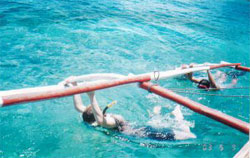Project Integrates Family Planning
and Reproductive Health Into Coastal
Resource Management
 |
| IPOPCORM members begin work on
establishing a Marine Protected Area. Source: IPOPCORM |
“Our sea is our life! Why do you restrict us from getting its resources,
which were given to us by God? The sea is our primary source of
income. Who will provide us the food for our family? What will happen
to our children, who are our future generation, when you deprive us
from using the sea to provide food and education? Can you provide
the means to supplement our needs?”
This was Candilario Piloton’s reaction in response to establishing a
Marine Protected Area (MPA) in the coastal waters near his village of
Panas, on Bohol Island in the Philippines. He worried that establishing
an MPA would restrict fishing, causing hardships for the many fishermen
in the village who depended on fishing for both income and sustenance.
What Candelario did not realize is that the coastal waters off Panas were
in danger; too many fishermen were vying for far too few fish. Philippine
waters used to provide a bountiful supply of fish and other marine species
like sea urchins and mollusks for local and export consumption, making
fish the most popular source of protein in the country. However, as the
Philippine population swelled and demand for fish grew, devastating
fishing methods and an influx of local and commercial fishermen
reduced stocks to unsustainable levels.
On Bohol Island, this phenomenon was turning into a race for fish.
Many fishermen were resorting to the highly destructive, yet effective,
dynamite fishing method. Using this technique, a fisherman essentially
throws a mix of lime and common soil fertilizer into the water, which
explodes and sends shock waves through the sea stunning or killing
fish. Although fishermen can harvest up to three times more fish with
the dynamite method then their normal hook-and-line method, the
explosion destroys the coral reefs and seagrass areas that serve as
nurseries and habitats for fish. Without their habitats, fish cannot
reproduce and replenish their stocks.
Understanding the threat that destructive fishing and overfishing posed
to its citizens, policymakers in the municipality of Candijay and its eight
coastal villages, one of which is Panas, decided to establish an MPA.
A popular coastal management approach in the Philippines, an MPA
prohibits fishing within a protected segment of the ocean floor, creating
a fish sanctuary and allowing the coral reefs to recover and regenerate.
Regular sea patrols around the MPA deter illegal activities such asdynamite fishing. However, the municipality often faced severe
opposition from fishermen like Candelario, who worried that closing
waters to fishing would mean hardship for himself and his family.
 |
A coral bed in a Marine Protected Area
in the Philippines.
Source: IPOPCORM |
There was a turning point, however, when the Integrated Population
and Coastal Resource Management (IPOPCORM) Project, implemented
by PATH Foundation Philippines with funding from the U.S. Agency
for International Development (USAID) and the Packard Foundation,
approached Candijay with a proposition. As project staff pointed out,
the growing population of Candijay was a major factor in the continuous
exploitation of its marine resources. It was common for coastal families
to have six or more children, and fishermen were under pressure to
provide for their large families. IPOPCORM staff proposed a project
that would educate fisherman and their families on the benefits of smaller healthier families, give them the
access they currently lacked to family planning products and services, and encourage them to protect their
marine resources using the MPA. Drawing the link between large family size and the limited coastal resources
made sense to the community members and helped them to better understand the need to protect and manage
their environment.
The mayor and her council members agreed and the IPOPCORM project started.
- A community-based peer education program counseled couples on how to best plan their families.
- A community-based commodity distribution program supported and encouraged access to family planning
and reproductive health supplies at affordable prices.
- A microcredit program was started to help community members, particularly fisher-families, identify
alternative livelihoods and access small loans as a means to increase non-sea income.
- After considerable education and community organizing, the project won the approval of the people of
Panas to establish the MPA. The Marine Sanctuary Management Team, an advisory body made up of
local officials and villagers, was established to manage the MPA and trained on basic coral and fisheries
health monitoring approaches.
Mr. Candelario Piloton is now the Vice-Chairperson of the Marine Sanctuary Management Team and member
of the MPA monitoring team. He is convinced that the sea will continue to provide affordable and sustainable
food for his family, with the help of the MPA. As a trained male peer educator, he is confident promoting and
advocating male involvement in family planning among his friends and colleagues. His wife Susana decided
to have a bilateral tubal ligation after bearing her last child and is happy to talk to her friends and neighbors
about the procedure. Candelario and Susana are effective advocates and role models for the importance of
taking a holistic view to their community’s health and well-being. They both believe that the cycle of food
insecurity and poverty in coastal communities can be overcome if there is full participation of the people in
the management of their own coastal resources and the accessibility of voluntary family planning information
and services.
Based on a case study written by Leonila N. Ampusta, a community volunteer for PROCESS Bohol, a local NGO partner to PATH
Foundation Philippines (PFPI), 2006. PFPI and local partner PROCESS Bohol implemented the Integrated Population and Coastal
Resource Management (IPOPCORM) Project in Bohol, 2001–2008.
January 2008
Related Resources
|


